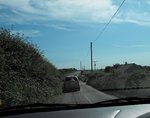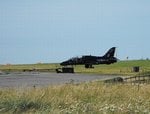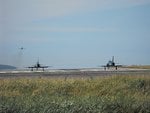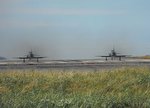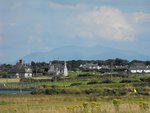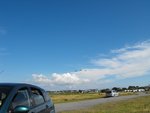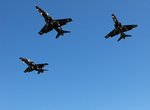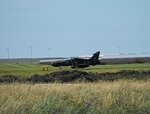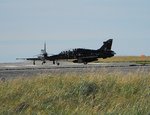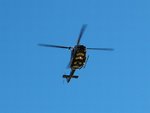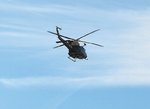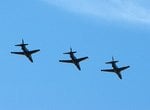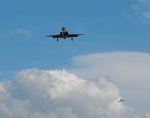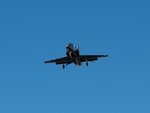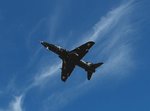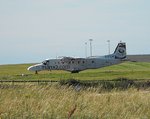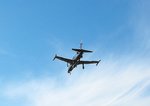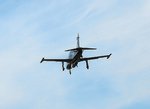Airframes
Benevolens Magister
A couple of friends and myself visited RAF Valley, or at least the viewing areas, on Thursday, a day of blue skies and hot sun, which made a change!
This RAF station is located at the north west corner of the island of Anglesey, across the Menai Straits from North Wales, and is now the only fast jet training base in the UK. Apart from 4 FTS (4 Flying Training School), all of the other jet training organisations have been moved to this station, including the Tactical Weapons Unit formerly at Brawdy, and 'shadow' squadrons such a 92 Squadron and 4 Squadron, which undertake advanced training such as air combat and ground attack, this being done on the nearby sea ranges, and in the mountains of North Wales, as well as farther afield.
Also based here is the SAR Helicopter Training Unit, equipped with the Griffin ( modernised version of the venerable 'Huey'), and 'C' Flight, 22 (SAR) Squadron, with their Sea King helicopters which, of course, is the unit where Prince William 'works'.
In order to find out 'what was happening', we tipped up at the public viewing area near the airfield's main gate, which is slap bang on the threshold of Runway 19, and where the Valley Aviation Society cabin is located. From this location, there is a good view across the northern apron to the control tower and, if Runway 19 is in use, aircraft taxi past literally only yards away, with the threshold of the runway in clear view, requiring only a relatively 'short' camera lens in order to get some good shots.
As it happened, the runway in use was RW32, with it's approach over the beach near Rosneigr, a drive of around 9 miles through narrow country lanes, and, although I knew there was a good viewing area near that location, I had no idea how to get there. However, the extremely helpful and friendly volunteer on duty in the Valley Aviation Society cabin, not only provided plenty of information, but also guided us there, leading the way in his car, until all we had to do was drive down a bumpy, sandy track, which opened out onto the flat area above the beach, right on the edge of the airfield, and directly in line with RW32 - brilliant!
Suffice to say we had an excellent day out, on the edge of a Nature Reserve, and with various types of Hawk doing 'running breaks', formation and stream landings and take offs, and a couple of visiting aircraft to boot, including a German civilian registered Dornier feeder liner.
There's a camp site right on the spot where we parked, and we plan to go back for a couple of days within the next few weeks, weather permitting, when we hope to catch some 'heavier metal' dropping in.
The pics below show some of what was going on, and I've annotated those which need a bit of explanation.
PICS 1 and 2. Location map and airfield plan.
PIC 3. The Station name board, in Welsh and English, with the Crests of those Squadrons based at Valley.
PIC 4. Gate guard Hunter T8, in the somewhat faded colours used by 4 FTS when Hunters were based here, up to the late 1970s'.
This aircraft started life as a Hunter F4, with 20 Sqn at Oldenburg,Germany, before moving to 228 OCU at Chivenor, Devon, UK. It was then converted to a T8 for the Royal Navy, seeing various postings, and being in storage for some time, before being painted as a T7 of 4 FTS, and put on display in 1997.
PIC 5. The north apron and control tower, showing just how close and clearly visible the airfield is from the viewing area. It was a bit difficult to get good, sharp photos, as the heat haze rising from the concrete was very distorting!
PIC 6 Hawks on the north apron, preparing for a sortie.
PIC 7. Two Hawk T2s climb out from the more distant RW 32. These are the second-generation Hawk, similar to the export Hawk 200, with 'modern' cockpits and avionics, and able to carry various weapons packages. The Hawk T1 is the basic, advanced trainer.
PIC 8. This Sea King is climbing out from the heat haze over the SARF apron, about a mile away, across the airfield.
PIC 9. Although no sign of any aircraft on this occasion, this is how close the threshold of Runway 19 is, with the taxi track in the middle foreground.
PIC 10. The aerial view, courtesy of the Valley Aviation Society, shows our frirst location, at the point marked 1. We then moved on to the beach side location, shown at 4 on the picture, and tomorrow I'll post some pics taken there.
I was very slightly limited with the 'action' shots, as I was using my Fuji F1000, a 'bridge' camera. Although it has a zoom lens equivalent to a 390mm, and a 'continuous shooting' mode, unlike good DSLRs, the electronic viewfinder is 'blanked' once the first shot is taken, causing a delay in viewing, but it coped well, and I managed some reasonable photos. Next visit, I'll be borrowing my ex-wife's Nikon DSLR !!
This RAF station is located at the north west corner of the island of Anglesey, across the Menai Straits from North Wales, and is now the only fast jet training base in the UK. Apart from 4 FTS (4 Flying Training School), all of the other jet training organisations have been moved to this station, including the Tactical Weapons Unit formerly at Brawdy, and 'shadow' squadrons such a 92 Squadron and 4 Squadron, which undertake advanced training such as air combat and ground attack, this being done on the nearby sea ranges, and in the mountains of North Wales, as well as farther afield.
Also based here is the SAR Helicopter Training Unit, equipped with the Griffin ( modernised version of the venerable 'Huey'), and 'C' Flight, 22 (SAR) Squadron, with their Sea King helicopters which, of course, is the unit where Prince William 'works'.
In order to find out 'what was happening', we tipped up at the public viewing area near the airfield's main gate, which is slap bang on the threshold of Runway 19, and where the Valley Aviation Society cabin is located. From this location, there is a good view across the northern apron to the control tower and, if Runway 19 is in use, aircraft taxi past literally only yards away, with the threshold of the runway in clear view, requiring only a relatively 'short' camera lens in order to get some good shots.
As it happened, the runway in use was RW32, with it's approach over the beach near Rosneigr, a drive of around 9 miles through narrow country lanes, and, although I knew there was a good viewing area near that location, I had no idea how to get there. However, the extremely helpful and friendly volunteer on duty in the Valley Aviation Society cabin, not only provided plenty of information, but also guided us there, leading the way in his car, until all we had to do was drive down a bumpy, sandy track, which opened out onto the flat area above the beach, right on the edge of the airfield, and directly in line with RW32 - brilliant!
Suffice to say we had an excellent day out, on the edge of a Nature Reserve, and with various types of Hawk doing 'running breaks', formation and stream landings and take offs, and a couple of visiting aircraft to boot, including a German civilian registered Dornier feeder liner.
There's a camp site right on the spot where we parked, and we plan to go back for a couple of days within the next few weeks, weather permitting, when we hope to catch some 'heavier metal' dropping in.
The pics below show some of what was going on, and I've annotated those which need a bit of explanation.
PICS 1 and 2. Location map and airfield plan.
PIC 3. The Station name board, in Welsh and English, with the Crests of those Squadrons based at Valley.
PIC 4. Gate guard Hunter T8, in the somewhat faded colours used by 4 FTS when Hunters were based here, up to the late 1970s'.
This aircraft started life as a Hunter F4, with 20 Sqn at Oldenburg,Germany, before moving to 228 OCU at Chivenor, Devon, UK. It was then converted to a T8 for the Royal Navy, seeing various postings, and being in storage for some time, before being painted as a T7 of 4 FTS, and put on display in 1997.
PIC 5. The north apron and control tower, showing just how close and clearly visible the airfield is from the viewing area. It was a bit difficult to get good, sharp photos, as the heat haze rising from the concrete was very distorting!
PIC 6 Hawks on the north apron, preparing for a sortie.
PIC 7. Two Hawk T2s climb out from the more distant RW 32. These are the second-generation Hawk, similar to the export Hawk 200, with 'modern' cockpits and avionics, and able to carry various weapons packages. The Hawk T1 is the basic, advanced trainer.
PIC 8. This Sea King is climbing out from the heat haze over the SARF apron, about a mile away, across the airfield.
PIC 9. Although no sign of any aircraft on this occasion, this is how close the threshold of Runway 19 is, with the taxi track in the middle foreground.
PIC 10. The aerial view, courtesy of the Valley Aviation Society, shows our frirst location, at the point marked 1. We then moved on to the beach side location, shown at 4 on the picture, and tomorrow I'll post some pics taken there.
I was very slightly limited with the 'action' shots, as I was using my Fuji F1000, a 'bridge' camera. Although it has a zoom lens equivalent to a 390mm, and a 'continuous shooting' mode, unlike good DSLRs, the electronic viewfinder is 'blanked' once the first shot is taken, causing a delay in viewing, but it coped well, and I managed some reasonable photos. Next visit, I'll be borrowing my ex-wife's Nikon DSLR !!
Attachments
-
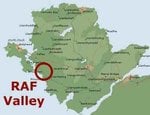 valley.jpg8.1 KB · Views: 122
valley.jpg8.1 KB · Views: 122 -
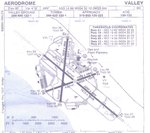 Valley 116.jpg322.4 KB · Views: 107
Valley 116.jpg322.4 KB · Views: 107 -
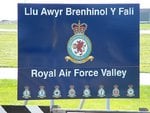 Valley 011.jpg122.9 KB · Views: 108
Valley 011.jpg122.9 KB · Views: 108 -
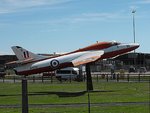 Valley 009.jpg116.1 KB · Views: 114
Valley 009.jpg116.1 KB · Views: 114 -
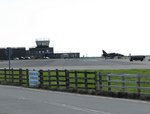 Valley 030.jpg81.7 KB · Views: 115
Valley 030.jpg81.7 KB · Views: 115 -
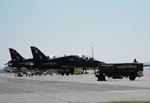 Valley 021.jpg80.1 KB · Views: 111
Valley 021.jpg80.1 KB · Views: 111 -
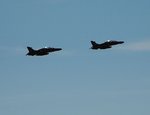 Valley 032.jpg59.3 KB · Views: 115
Valley 032.jpg59.3 KB · Views: 115 -
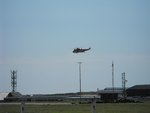 Valley 012.jpg44.3 KB · Views: 116
Valley 012.jpg44.3 KB · Views: 116 -
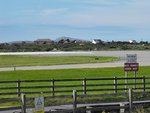 Valley 014.jpg109.7 KB · Views: 117
Valley 014.jpg109.7 KB · Views: 117 -
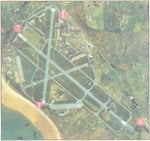 Valley 117.jpg80.8 KB · Views: 117
Valley 117.jpg80.8 KB · Views: 117

